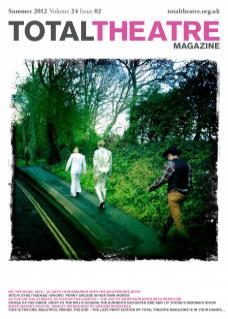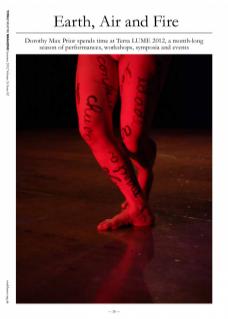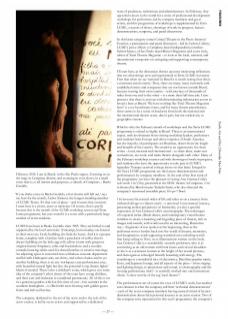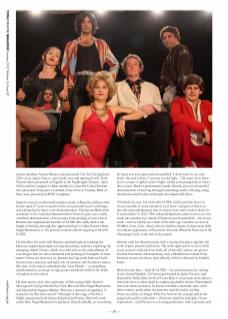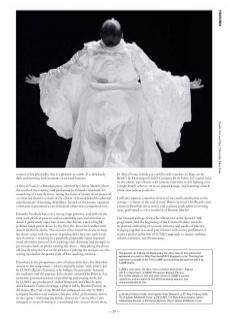February 2012: I am in Brazil, in the São Paulo region. Zooming in on the map, in Campinas district; and zooming in even closer, in a small town that is, to all intents and purposes, a suburb of Campinas – Barão Geraldo.
‘If you shake a tree in Barão Geraldo, a few clowns will fall out,’ says my host for the month, Carlos Simioni, the longest-standing member of LUME Teatro. It’s that sort of place – and it seems that everyone I meet here is a clown, actor or musician. Of course, that is partly because this is the month of the LUME workshop season and Terra Lume programme, but year-round it is a town with a particularly large number of artist-residents.
LUME have been in Barão Geraldo since 1985. They are linked to and supported by the local university (Unicamp), but nowadays are housed in their own very lovely building, the Sede do Lume. And it is a proper home, complete with a kitchen with a percolator of coffee almost always bubbling on the hob; egg-yolk yellow rooms with gorgeous original feature fireplaces, sofas and bookshelves; and a wooden veranda boasting tables used for shared lunches or creative meetings. An adjoining space is converted into a fabulous costume department stuffed with Harlequin suits, net skirts, and velvet cloaks; and in yet another building, there is an airy workspace cum performance area, with beautiful natural light but also the potential to rig theatre lights/ blacks if needed. There’s also a children’s room, which gives you some idea of the company’s ethos (many of the team have young children, and their care and inclusion is considered paramount). All of this is set in a generous garden, which at this time of year – late summer in the southern hemisphere – is filled with trees heaving with golden guava fruits and rich-red berries.
The company, dedicated to the art of the actor and to the role of the actor-creator, is led by seven actors and supported by a dedicated team of producers, technicians and administrators. In February, they open their doors to the world for a series of professional development workshops for performers, led by company members and guest artists, and this programme of workshops is supplemented by Terra LUME, a season of shows, showings of work-in-progress, lecture-demonstrations, symposia, and panel discussions.
In this latter category comes Critical Theatre in the Press: Interior/ Exterior, a presentation and panel discussion – led by Carlota Cafiero, LUME’s press officer; a Campinas-based independent journalist; Valmir Santos, of Sao Paulo based Bravo! Magazine; and yours truly, editor of Total Theatre Magazine – to look at the local, national, and international viewpoints on critiquing and supporting contemporary theatre.
I’ll start here, as the discussion throws up some interesting reflections that set other things seen and experienced in Terra LUME in context. First that when we say ‘national’ in Brazil it is worth noting that this is a continent-sized country. Thus, there are many, many extremely well-established artists and companies that are not known outside Brazil, because touring their own country – with journeys of thousands of miles from one end to the other – is a more than full-time job. I also perceive that there is an issue with disseminating information across so broad a base as Brazil. ‘We have nothing like Total Theatre Magazine here!’ is a cry heard many times, and for many theatre practitioners, there seems to be a sense of insularity from both the national and the international theatre scene, due in part, but not exclusively, to geographic reasons.
Which is why the February month of workshops and the Terra LUME programme is valued so highly in Brazil. There is an international aspect, with involvement from visiting workshop leaders, performers and students from Europe and other countries of South America, but the majority of participants are Brazilian, drawn from the length and breadth of the country. The month is an opportunity for those artists – local, national and international – to share ideas, make new connections, see work, and make theatre alongside each other. Many of the February workshop courses end with showings of work-in-progress, and students also have the opportunity to take part in LUME’s legendary Trueque carnival cortege (more on that later). Integral to the Terra LUME programme are the lecture-demonstrations and performances by company members. At the end of the first week of the programme, we have the pleasure of seeing Ana Cristina Colla’s solo work Você (You), presented at the SESC theatre in Campinas. Você is directed by Butoh master Tadashi Endo, who also directed the company’s renowned ensemble piece Shi-zen 7 Bowls.
Você reverses the natural order of life and takes us on a journey from withered old age to vibrant youth – a universal ‘everywoman’ journey, presenting archetypal pictures of femininity, yet also a specific expression of Ana Cristina Colla’s own biography. The techniques of corporeal mime, Butoh dance, and contemporary visual theatre combine to create a haunting and beguiling piece of theatre, rich in images and sounds, with words used in an interesting, illustrative way – fragments of text spoken at the beginning, then as the performer moves further back into the world of dreams, memories, and imagination, words appearing scrawled onto unfurling scrolls that hang ceiling to floor, or as illuminations written on the body. Ana Cristina Colla is a wonderfully versatile performer, who is as convincing as an old woman with bent knees and curved shoulders as she is as a sensuous woman at the height of her sexual prowess, and then again as schoolgirl literally bouncing with energy. The soundscape is a wonderful mix of electronica, Brazilian popular music, Koto, and Japanese lounge, and all aspects of the piece – from staging and lighting design, to projections and sound, to choreography and the riveting performance itself – is carefully worked into one harmonious whole. A show worthy of the tag ‘total theatre’!
The performances are of course the crux of LUME’s work, but another core element is what the company call their ‘technical demonstrations’ – each of the seven company members having created a kind of lecture-demonstration about their personal journey as an actor-creator. Two of the company were represented in this year’s programme: the company’s newest member, Naomi Silman, who presented Não Tem Flor Quadrada (There are no Square Flowers – previously seen and reported on by Total Theatre when presented in English at the Nightingale Theatre, April 2011); and the company’s oldest member, co-founder Carlos Simioni, who presented Prisão para a Liberdade (From Prison to Freedom). Both of these were presented at SESC Campinas.
Simioni starts in confessional-narrator mode, telling the audience that he has spent 27 years in search of his own personal actor’s technique, and joking that he hates to do demonstrations. Having established his resistance to the ‘technical demonstration’ form, he goes on to make a brilliant demonstration of his journey from protégé of Luís Otávio Burnier (the inspirational founder of LUME who sadly died at the height of his life), through his ‘apprenticeship’ to Odin Teatret’s Iben Nagel Rasmussen, to the present moment and his ongoing work with LUME.
He describes his work with Burnier, painstakingly developing the Decroux-inspired principles of corporeal mime, and then exploring the emerging ‘matrix’ forms, which we could view as the embodiment of core images that are often elemental and archetypal. Examples of these ‘matrix’ forms are shown to us, Simioni moving easily back and forth between the conscious and lucid role of narrator and the almost trancelike state of the matrix embodied (the ‘Lion Mouth’ – a compelling transformation, an image of rage, power and desire held on the brink of explosion into chaos).
He then moves on to the experience of first seeing Odin Teatret’s Marriage with God (performed by César Brie and Iben Nagel Rasmussen, and directed by Eugenio Barba). This was a moment of epiphany: ‘I wanted to be like these actors!’ Although at this stage of his life a highly experienced and talented physical performer, Simioni’s work under Iben Nagel Rasmussen’s guidance altered radically, as everything he knew was torn apart and reassembled: ‘I don’t want to see your body,’ she said to him, ‘I want to see the light…’ He went on to learn how to create ‘a spider’s web of light’ whilst yet learning how to ‘move like a stone’. Back in performance mode, Simioni gives us a beautiful demonstration of moving through contrasting modes of being, using the Samurai and Geisha archetypes developed with Iben.
Ultimately, he says, his work with LUME and beyond has been ‘to reveal yourself; to work outside of your fears’, and part of that is to face the acknowledgement that no matter how much work is done, he is ‘uma merda’ (‘a shit’). This acknowledgement seems to move us very easily into another key strand of Simioni’s professional life – his clown work – and we briefly see a flash of his alter-ego Carolino (co-star of LUME’s Cravo, Lírio e Rosa), who we had the chance to meet more fully in a cabaret appearance with partner Teotonio (Ricardo Puccetti) at the Almanaque Café, at the end of the month.
Simioni ends his demonstration with a maxim that glues together the work of past, present and future: ‘My work right now is to try to find a way to move with all of my body, all of my self’, and we are given a few brief moments of harmonious, truly embodied movement from his most recent solo show, Sopro (Breath), which is directed by Tadashi Endo.
Back at home base – Sede do LUME – two performances by visiting artists shined brightly. El Funeral, performed by Janko Navarro and directed by Erika Mata (both of Costa Rica) is a one-man show about a man who tries to cheat death by employing death’s tactics. Determined not to be taken unawares, he learns to mimic a catatonic state, until there comes a point when the pretence and the reality overlap. There are echoes of Edgar Allan Poe both in the concept and in the gorgeously gothic realisation – all intense shadows and uplit, frozen expressions – and Navarro is a riveting performer, with a presence and control of his physicality that is a pleasure to watch. It is deliciously dark and bursting with moments of twisted humour.
A Beira do Nada, is a Brazilian piece, directed by Claiton Manfro (from the south of the country) and performed by Eduardo Aranbula. It’s something of a tour de force, taking the form of twenty short pieces on a connected theme – a study of the effects of dementia and the physical manifestations of learning disabilities. In each of the twenty vignettes a character is presented as an abstracted observation, judgement free.
Eduardo Aranbula has a very strong stage presence, and delivers the work with physical prowess and an admirable care and attention to detail. I particularly enjoy two scenes that feature a pair of highly polished black patent shoes. In the first, the shoes are handled with almost fetishistic desire. The second circles round the desire to wear the shoes vying with the worry of putting dirty feet into such lovely new footwear – resulting in a painfully, poignantly funny repeated ritual of trouser removal, foot washing, shoe donning, and attempts to get trousers back on whilst wearing the shoes – then taking the shoes off, but dirtying the feet in the process of putting the trousers on, this setting up another desperate cycle of foot washing, etcetera…
Elsewhere in the programme came a lecture-with-beer (the Brazilian answer to the symposium – which originally meant ‘with wine’!) led by LUME’s Renato Ferracini, who bridges the gap nicely between the academic and the practice-led concerns around The Body in Art; numerous practical sessions on producing and touring work, led by LUME’s ace producers, Cynthia Margareth and Dani Scopin; and a fantastic Carnival cortege, a project led by Ricardo Pucetti on the theme The End of the World that embraced not only LUME’s company members and students, but also other performance artists in the region – including the female clown Lily Curcio, who I also managed to see performing in a wonderful two-woman clown show, De Malas Prontas (which you could loosely translate as ‘Bags at the Ready’) by Florianópolis-based Company Pé de Vento. It’s a great twist on the classic ‘two clowns with suitcases and time to kill fighting over a single bench’ wheeze, set in an airport lounge, and featuring a battle of the clown divas to die for.
I will also squeeze a mention in here of my small contribution to the cortege – a ‘dance at the end of time’ Bolero devised with Ricardo and a team of Brazilian street artists and students resplendent in evening wear, performed to a live rendition of Besame Mucho!
The Trueque cortege marks the official end of the Terra LUME programme, and the beginning of the Carnival holiday week. In its glorious embracing of so many artforms and modes of practice, bringing together seasoned practitioners with novice performers, it seems a perfect reflection of LUME’s approach to theatre-making: eclectic, inclusive, and illuminating.
The section on A Beira do Nada and a few other lines in this article first appeared in a post on http://terralume2012.blogspot.co.uk/ The blog has extensive coverage of the Terra LUME and workshop programme 2012 by LUME Teatro. LUME’s new show, Os Bem-Intencionados, premieres 1 August 2012, in São Paulo, at SESC Pompeia’s Espaço Cênico. For further details on this and other shows in LUME’s current repertoire, and for plans for the 2013 workshop season, see www.lumeteatro.br.com
